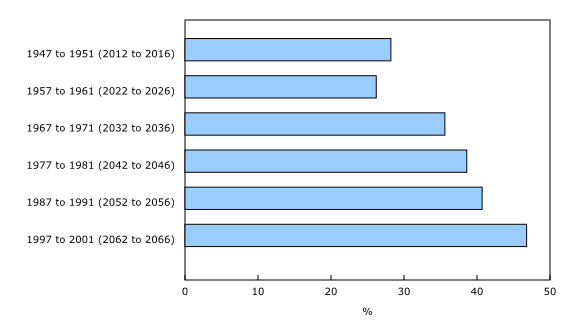Study: The contribution of immigration to the size and ethnocultural diversity of future cohorts of seniors
Archived Content
Information identified as archived is provided for reference, research or recordkeeping purposes. It is not subject to the Government of Canada Web Standards and has not been altered or updated since it was archived. Please "contact us" to request a format other than those available.
Released: 2016-03-09
The aging of Canada's population is currently related to the baby-boom cohort reaching their senior years. Subsequent cohorts will continue to sustain high populations of seniors because of declining mortality rates and higher immigration levels.
According to population projections, future cohorts of older Canadians could also be more ethnoculturally diverse, as a larger portion of them could be born outside of Canada.
These findings are included in a new article released today, titled "The contribution of immigration to the size and ethnocultural diversity of future cohorts of seniors."
The study focused on several cohorts of current and future seniors. These included those born between 1937 and 1941, 1957 and 1961 (born during the baby-boom period), 1967 and 1971 (born during the baby-bust period), and 1997 and 2001 (people who will be aged 65 between 2062 and 2066).
Using population projections and other population data sources, the study compared the projected size and characteristics of each of these cohorts at age 65.
The population size of younger cohorts could be less affected by mortality
Among the 1.2 million Canadians born between 1937 and 1941, 19% did not live to the age of 65.
Because of immigration, however, the population at age 65 of those born between 1937 and 1941 exceeded by 36% the number that would have been expected had mortality been the only factor driving population changes.
In contrast, the size of younger cohorts could be less affected by mortality as a result of declining mortality rates. Their population size is also projected to be more influenced by immigration, should immigration remain at its current levels in coming decades.
For example, 6% of the 1.7 million people who were born between 1997 and 2001 are expected to die before the age of 65. At this age, however, immigration may boost the size of this cohort by 73%.
The baby-boom cohort is expected to be less diverse than other cohorts
Of all cohorts studied, those born between 1957 and 1961 had the largest population at birth (2.4 million). However, when individuals from this cohort reached their 20s and 30s (typically the ages at which most immigrants come to Canada) during the 1980s, immigration levels were lower.
As a result, this cohort experienced less immigration between the ages of 0 and 65. At age 65, their projected population could exceed by 28% the size that would have been expected had mortality been the sole factor.
This cohort of baby boomers could also be less ethnoculturally diverse when its members reach the age of 65.
For example, 26% of individuals born between 1957 and 1961 could be born abroad when they reach 65.
By comparison, this could be the case for 47% of individuals born between 1997 and 2001 when they reach 65, if immigration remains at current levels.
In addition, 17% of people born between 1957 and 1961 could belong to a visible minority group at age 65. This proportion could rise to 44% for people born between 1997 and 2001 when they reach the same age.
Birthplace of immigrants in senior population also expected to change
The birthplace of immigrants in the senior population is also projected to change over successive cohorts at age 65.
More specifically, the proportion of individuals aged 65 and born in Europe could decline rapidly from one cohort to the next, while those originating from Asia could increase.
In fact, starting with the 1967-to-1971 cohort, most foreign-born individuals could come from Asia when they reach 65.
Note to readers
This article is based on several data sources, including the Population Estimates Program and the Population Projections Program. Two sets of population projections were used: the Population Projections for Canada (2013-2063), Provinces and Territories (2013-2038) and special tabulations derived from the microsimulation model, Demosim.
As with any projection exercise carried out at Statistics Canada, the projections propose a number of scenarios on future trends, which can produce different results. These multiple scenarios reflect the uncertainty inherent in any attempt to project the future.
The results in this release are based on the medium growth (or reference) scenario, but the full article provides more information on the results obtained from other scenarios ("high" and "low" growth). These alternative scenarios do not change the overall conclusions of the article.
Products
The article "The contribution of immigration to the size and ethnocultural diversity of future cohorts of seniors" is now available in Insights on Canadian Society (75-006-X) from the Browse by key resource module of our website, under Publications.
Contact information
For more information, contact us (toll-free 1-800-263-1136; 514-283-8300; STATCAN.infostats-infostats.STATCAN@canada.ca).
To enquire about the concepts, methods or data quality of this release, contact Laurent Martel (613-220-4094; laurent.martel@canada.ca).
For more information on Insights on Canadian Society, contact Sébastien LaRochelle-Côté (613-951-0803; sebastien.larochelle-cote@canada.ca).
- Date modified:



